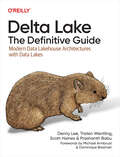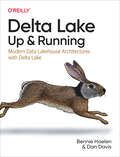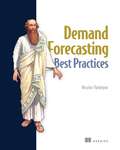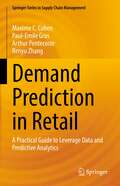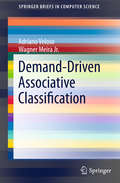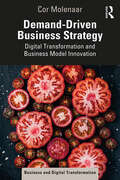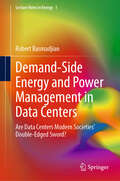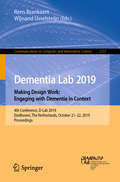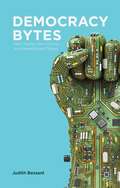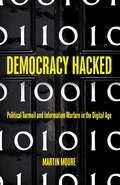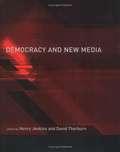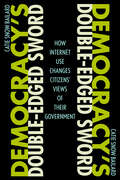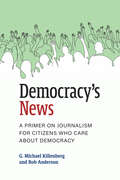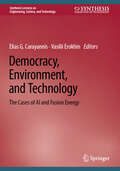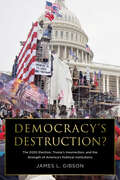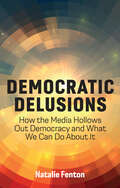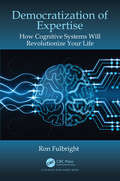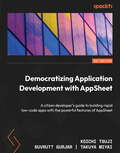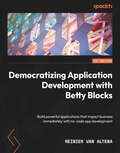- Table View
- List View
Delta Lake: Modern Data Lakehouse Architectures with Data Lakes
by Denny Lee Scott Haines Tristen Wentling Prashanth BabuReady to simplify the process of building data lakehouses and data pipelines at scale? In this practical guide, learn how Delta Lake is helping data engineers, data scientists, and data analysts overcome key data reliability challenges with modern data engineering and management techniques.Authors Denny Lee, Tristen Wentling, Scott Haines, and Prashanth Babu (with contributions from Delta Lake maintainer R. Tyler Croy) share expert insights on all things Delta Lake--including how to run batch and streaming jobs concurrently and accelerate the usability of your data. You'll also uncover how ACID transactions bring reliability to data lakehouses at scale.This book helps you:Understand key data reliability challenges and how Delta Lake solves themExplain the critical role of Delta transaction logs as a single source of truthLearn the Delta Lake ecosystem with technologies like Apache Flink, Kafka, and TrinoArchitect data lakehouses with the medallion architectureOptimize Delta Lake performance with features like deletion vectors and liquid clustering
Delta Lake: Modern Data Lakehouse Architectures with Delta Lake
by Bennie Haelen Dan DavisWith the surge in big data and AI, organizations can rapidly create data products. However, the effectiveness of their analytics and machine learning models depends on the data's quality. Delta Lake's open source format offers a robust lakehouse framework over platforms like Amazon S3, ADLS, and GCS.This practical book shows data engineers, data scientists, and data analysts how to get Delta Lake and its features up and running. The ultimate goal of building data pipelines and applications is to gain insights from data. You'll understand how your storage solution choice determines the robustness and performance of the data pipeline, from raw data to insights.You'll learn how to:Use modern data management and data engineering techniquesUnderstand how ACID transactions bring reliability to data lakes at scaleRun streaming and batch jobs against your data lake concurrentlyExecute update, delete, and merge commands against your data lakeUse time travel to roll back and examine previous data versionsBuild a streaming data quality pipeline following the medallion architecture
Demand Forecasting Best Practices
by Nicolas VandeputLead your demand planning process to excellence and deliver real value to your supply chain.In Demand Forecasting Best Practices you&’ll learn how to: Lead your team to improve quality while reducing workload Properly define the objectives and granularity of your demand planning Use intelligent KPIs to track accuracy and bias Identify areas for process improvement Help planners and stakeholders add value Determine relevant data to collect and how best to collect it Utilize different statistical and machine learning models An expert demand forecaster can help an organization avoid overproduction, reduce waste, and optimize inventory levels for a real competitive advantage. Demand Forecasting Best Practices teaches you how to become that virtuoso demand forecaster. This one-of-a-kind guide reveals forecasting tools, metrics, models, and stakeholder management techniques for delivering more effective supply chains. Everything you learn has been proven and tested in a live business environment. Discover author Nicolas Vandeput&’s original five step framework for demand planning excellence and learn how to tailor it to your own company&’s needs. Illustrations and real-world examples make each concept easy to understand and easy to follow. You&’ll soon be delivering accurate predictions that are driving major business value. About the Technology An expert demand forecaster can help an organization avoid overproduction, reduce waste, and optimize inventory levels for a real competitive advantage. This book teaches you how to become that virtuoso demand forecaster. About the Book Demand Forecasting Best Practices reveals forecasting tools, metrics, models, and stakeholder management techniques for managing your demand planning process efficiently and effectively. Everything you learn has been proven and tested in a live business environment. Discover author Nicolas Vandeput&’s original five step framework for demand planning excellence and learn how to tailor it to your own company&’s needs. Illustrations and real-world examples make each concept easy to understand and easy to follow. You&’ll soon be delivering accurate predictions that are driving major business value. What's Inside Enhance forecasting quality while reducing team workload Utilize intelligent KPIs to track accuracy and bias Identify process areas for improvement Assist stakeholders in sales, marketing, and finance Optimize statistical and machine learning models About the Reader For demand planners, sales and operations managers, supply chain leaders, and data scientists. About the Author Nicolas Vandeput is a supply chain data scientist, the founder of consultancy company SupChains in 2016, and a teacher at CentraleSupélec, France. Table of Contents: Part 1 - Forecasting demand 1 Demand forecasting excellence 2 Introduction to demand forecasting 3 Capturing unconstrained demand (and not sales) 4 Collaboration: data sharing and planning alignment 5 Forecasting hierarchies 6 How long should the forecasting horizon be? 7 Should we reconcile forecasts to align supply chains? Part 2 - Measuring forecasting quality 8 Forecasting metrics 9 Choosing the best forecasting KPI 10 What is a good forecast error? 11 Measuring forecasting accuracy on a product portfolio Part 3 - Data-driven forecasting process 12 Forecast value added 13 What do you review? ABC XYZ segmentations and other methods Part 4 - Forecasting methods 14 Statistical forecasting 15 Machine learning 16 Judgmental forecasting 17 Now it&’s your turn!
Demand Prediction in Retail: A Practical Guide to Leverage Data and Predictive Analytics (Springer Series in Supply Chain Management #14)
by Maxime C. Cohen Paul-Emile Gras Arthur Pentecoste Renyu ZhangFrom data collection to evaluation and visualization of prediction results, this book provides a comprehensive overview of the process of predicting demand for retailers. Each step is illustrated with the relevant code and implementation details to demystify how historical data can be leveraged to predict future demand. The tools and methods presented can be applied to most retail settings, both online and brick-and-mortar, such as fashion, electronics, groceries, and furniture. This book is intended to help students in business analytics and data scientists better master how to leverage data for predicting demand in retail applications. It can also be used as a guide for supply chain practitioners who are interested in predicting demand. It enables readers to understand how to leverage data to predict future demand, how to clean and pre-process the data to make it suitable for predictive analytics, what the common caveats are in terms of implementation and how to assess prediction accuracy.
Demand Response in Smart Microgrids: Advanced and Optimal Energy Management Strategies (Studies in Systems, Decision and Control #619)
by Mohammed Ouassaid Rajaa Naji El Idrissi Meryeme AzaroualThis book covers the optimization of the energy flow management of a grid-tied photovoltaic-wind-battery energy storage system and the development of demand response algorithms for a single customer at the lowest level and extended it to a large community of participants at the highest level. Hence, this book consists of two parts. The first part is devoted to the design of energy management strategies for a residential PV-WT system, while considering time of use and feed in tariff schemes. Further, the developed management algorithms mitigate the greenhouse gas emissions. Additionally, a closed-loop control based-model predictive control scheme, to forecast the system behavior and deal with renewable energy resources and load disturbances, is elaborated. The second part is dedicated to developing effective demand side management techniques and cooperative energy scheduling in the framework of collective smart-buildings. Cooperative energy scheduling programs are designed while considering three objectives: minimizing peak load, minimizing electricity cost, and avoiding the occurrence of rebound peaks. Optimal consumption decisions are examined in residential, commercial, and industrial areas. Besides, the impact of electric vehicle charging methods is investigated for different EV penetration levels. Also, a game theory approach for energy consumption scheduling of a community of smart microgrids is built. In summary, this book successfully establishes the important synergy between microgrid energy management and demand response at the level of a smart home and an aggregated building community. The above aspects are illustrated in this book in 12 chapters. The scope is broad. This book chapters are very effective in theoretical analysis and design of optimization algorithms in the realm of smart grids. This book is intended to provide advanced undergraduate, graduate students, engineers, researchers on energy management within smart homes and clustered buildings, with a comprehensive understanding of various methods and designed algorithms. These strategies and algorithms aim to deal with defies ranging from augmented adoption of microgrids to the introduction of demand response approaches, to enhance the grid viability and resilience.
Demand-Driven Associative Classification
by Wagner Meira Jr. Adriano VelosoThe ultimate goal of machines is to help humans to solve problems. Such problems range between two extremes: structured problems for which the solution is totally defined (and thus are easily programmed by humans), and random problems for which the solution is completely undefined (and thus cannot be programmed). Problems in the vast middle ground have solutions that cannot be well defined and are, thus, inherently hard to program. Machine Learning is the way to handle this vast middle ground, so that many tedious and difficult hand-coding tasks would be replaced by automatic learning methods. There are several machine learning tasks, and this work is focused on a major one, which is known as classification. Some classification problems are hard to solve, but we show that they can be decomposed into much simpler sub-problems. We also show that independently solving these sub-problems by taking into account their particular demands, often leads to improved classification performance.
Demand-Driven Business Strategy: Digital Transformation and Business Model Innovation (Business and Digital Transformation)
by Cor MolenaarDemand-Driven Business Strategy explains the ways of transforming business models from supply driven to demand driven through digital technologies and big data analytics. The book covers important topics such as digital leadership, the role of artificial intelligence, and platform firms and their role in business model transformation. Students are walked through the nature of supply- and demand-driven models and how organizations transform from one to the other. Theoretical insights are combined with real-world application through global case studies and examples from Amazon, Google, Uber, Volvo and Picnic. Chapter objectives and summaries provide consistent structure and aid learning, whilst reflective questions encourage further thought and discussion. Comprehensive and practical, this is an essential text for advanced undergraduate and postgraduate students studying strategic management, marketing, business innovation, consumer behavior, digital transformation and entrepreneurship.
Demand-Side Energy and Power Management in Data Centers: Are Data Centers Modern Societies’ Double-Edged Sword? (Lecture Notes in Energy #1)
by Robert BasmadjianThis book explains the principles, foundations and methodologies adopted in data centers to achieve demand-side energy and peak power management. It gives a brief introduction about Smart Grid, how the transition from legacy to Smart Grid is realized, the different approaches for demand-side management (DSM), and then discusses the opportunities of data centers to achieve DSM and highlight the different considered optimization criterion. Data centers are the backbones in realizing digitization where they host ICT (information and communication technologies) resources like servers, storage devices and networking equipment. Despite their advantages in terms of providing numerous services to our modern society (e.g. social media, e-commerce, online learning), the major drawback is that data centers devour enormous amounts of energy. It is expected that the energy usage of data centers will increase in the next few years - expected to reach almost 25% of the world's overall consumption - due to the emerging and expanding technologies such as Blockchain and 5G.
Dementia Lab 2019. Making Design Work: 4th Conference, D-Lab 2019, Eindhoven, The Netherlands, October 21–22, 2019, Proceedings (Communications in Computer and Information Science #1117)
by Wijnand IJsselsteijn Rens BrankaertThis book constitutes the refereed proceedings of the 4th Dementia Lab Conference, D-Lab 2019, held in Eindhoven, The Netherlands, in October 2019. The 12 full and 7 short papers presented in this volume were carefully reviewed and selected from 53 submissions. The papers are organized in topical sections: inclusion & participation, technology & experience, and Dementia Lab ideas.
Dementia Lab 2021: Proceedings of the 5th Dementia Lab Conference, D-Lab 2021, January 18–28, 2021 (Design For Inclusion #2)
by Rens Brankaert Caylee Raber Maarten Houben Paulina Malcolm Jon HannanThis book gathers revised and selected contributions to the 5th Dementia Lab Conference, D-Lab 2021, organized online on January 18-28, 2021, from the Emily Carr University of Art + Design, Vancouver, Canada. It describes original strategies in which design or creative methods have been shown to uncover, support and enhance the abilities of people living with dementia. Papers report on new ideas and findings relating to three main themes: engagement, empowerment and identity. They cover: ethics of inclusion and solutions for shifting the culture of care to be focused on both personal independence and reconnecting with the community; new ways of designing with people living with dementia; strategies for breaking negative stereotypes and preconceived opinions; and approaches to retaining personhood and dignity. Offering a timely source of information on new design and creative methods to a broad community of industrial, communication, interactive and inclusive designers, this book is also meant to address and inspire various stakeholders and organizations in dementia care.
Democracy Bytes
by Judith BessantThis book is about new media, young people, the crisis of democracy and political renewal. It addresses a mixture of traditional and new questions: What is the political and political legitimacy? How do we understand politics in a 'network age'? Can we talk sensibly about the concept of a generation and generational change? Does democracy have a future? This book offers an optimistic assessment of how digital media supports new and distinctive forms of politics. Four case studies are offered: one considers performance art and protest in Russia, another investigates new media campaigns to defend the rights to freedom of speech and copyright in America, another inquires into indigenous art and interactive cartoons as politics in outback Australia and the last explores new forms of student action in schools and in the modern university.
Democracy Hacked: How Technology is Destabilising Global Politics
by Martin MooreTechnology has fractured democracy, and now there&’s no going back. All around the world, the fringes have stormed the palace of the elites and unleashed data miners, dark ads and bots on an unwitting public. After years of soundbites about connecting people, the social media giants are only just beginning to admit to the scale of the problem. We stand on the precipice of an era where switching your mobile platform will have more impact on your life than switching your government. Where freedom and privacy are seen as incompatible with social well-being and transparency. Where your attention is sold to the highest bidder. Our laws don&’t cover what is happening and our politicians don&’t understand it. But if we don&’t fight to change the system now, we may not get another chance.
Democracy and Media Decadence
by John KeaneWe live in a revolutionary age of communicative abundance in which many media innovations - from satellite broadcasting to smart glasses and electronic books - spawn great fascination mixed with excitement. In the field of politics, hopeful talk of digital democracy, cybercitizens and e-government has been flourishing. This book admits the many thrilling ways that communicative abundance is fundamentally altering the contours of our lives and of our politics, often for the better. But it asks whether too little attention has been paid to the troubling counter-trends, the decadent media developments that encourage public silence and concentrations of unlimited power, so weakening the spirit and substance of democracy. Exploring examples of clever government surveillance, market censorship, spin tactics and back-channel public relations, John Keane seeks to understand and explain these trends, and how best to deal with them. Tackling some tough but big and fateful questions, Keane argues that 'media decadence' is deeply harmful for public life.
Democracy and New Media
by Henry Jenkins David ThorburnDigital technology is changing our politics. The World Wide Web is already a powerful influence on the public's access to government documents, the tactics and content of political campaigns, the behavior of voters, the efforts of activists etc.
Democracy in the Disinformation Age: Influence and Activism in American Politics
by Regina Luttrell Lu Xiao Jon GlassIn this book established researchers draw on a range of theoretical and empirical perspectives to examine social media’s impact on American politics. Chapters critically examine activism in the digital age, fake news, online influence, messaging tactics, news transparency and authentication, consumers’ digital habits and ultimately the societal impacts that continue to be created by combining social media and politics. Through this book readers will better understand and approach with questions such as: • How exactly and why did social media become a powerful factor in politics? • What responsibilities do social networks have in the proliferation of factually wrong and hate-filled messages? Or should individuals be held accountable? • What are the state-of-the-art of computational techniques for measuring and determining social media's impact on society? • What role does online activism play in today’s political arena? • What does the potent combination of social media and politics truly mean for the future of democracy? The insights and debates found herein provide a stronger understanding of the core issues and steer us toward improved curriculum and research aimed at a better democracy. Democracy in the Disinformation Age: Influence and Activism in American Politics will appeal to both undergraduate and postgraduate students, as well as academics with an interest in areas including political science, media studies, mass communication, PR, and journalism.
Democracy's Double-Edged Sword: How Internet Use Changes Citizens' Views of Their Government
by Catie Snow BailardThe Internet has a clear, consistent, and considerable influence on democratic satisfaction.Winner of the APSA Best Book in Information Technology and Politics of the American Political Science AssociationThe beauty of democracy is not only that citizens can vote a candidate into office but that they can also vote one out. As digital media grows omnipresent, it becomes more important for political scientists and communication scholars to understand its influence on all aspects of the political process, from campaigning to governance. Catie Snow Bailard argues that the Internet—by altering the quantity and range of information available to citizens—directly influences the ability of individuals to evaluate government performance. It also affects public satisfaction with the quality of available democratic practices and helps motivate political activity and organization.Bailard originates two theories for democratization specialists to consider—mirror-holding and window-opening—which she tests using data collected from dozens of countries and two randomized field experiments. Mirror-holding explores how accessing the Internet allows citizens to see a more detailed and nuanced view of their own government’s performance. Window-opening, however, enables those same citizens to glimpse how other governments perform, particularly in comparison to their own.Although the book offers a robust empirical foundation for testing the Internet’s effects on democratic attitudes, Bailard ultimately concludes that access to information does not necessarily ensure that democracy will automatically flourish.
Democracy's Double-Edged Sword: How Internet Use Changes Citizens' Views of Their Government
by Catie Snow Bailard“Playing into the hands of neither the cyber-optimists nor the cyber-pessimists . . . this book makes a major contribution to our understanding.” —Talia Stroud, author of Niche News: The Politics of News ChoiceThe beauty of democracy is not only that citizens can vote a candidate into office but that they can also vote one out. As digital media has grown omnipresent, it becomes more important for political scientists and communication scholars to understand its influence on all aspects of the political process, from campaigning to governance. Catie Snow Bailard argues that the Internet—by altering the quantity and range of information available to citizens—directly influences the ability of individuals to evaluate government performance. It also affects public satisfaction with the quality of available democratic practices and helps motivate political activity and organization.Bailard originates two theories for democratization specialists to consider—mirror-holding and window-opening—which she tests using data collected from dozens of countries and two randomized field experiments. Mirror-holding explores how accessing the Internet allows citizens to see a more detailed and nuanced view of their own government’s performance. Window-opening, however, enables those same citizens to glimpse how other governments perform, particularly in comparison to their own.This book offers a robust empirical foundation for testing the Internet’s effects on democratic attitudes—and reminds us that access to information does not necessarily ensure that democracy will automatically flourish.“An outstanding book on democracy and the Internet…highly original.” —Choice
Democracy's News: A Primer on Journalism for Citizens Who Care about Democracy
by Rob Anderson G. Michael KillenbergSince the Founding, America’s faith in a democratic republic has depended on citizens who could be trusted to be communicators. Vigorous talk about equality, rights, and collaboration fueled the Revolution, the Declaration of Independence, and the Constitution with its amendments. In a republic, the people set the terms for their lives not individually, but in community. The genius of keeping it alive exists in how everyday citizens talk and listen, write and read, for a common good. Dialogue and deliberation—rather than an accumulation of individual preferences—sustains a republic, yet a diminished and scarred institution of journalism jeopardizes citizens’ access to shared and truthful information. A disturbing “what’s in it for me?” attitude has taken over many citizens, and a creeping, autocratic sense of dismissive accusation too often characterizes the political style of elected officials. The basic fuel for democracy is the willingness of informed citizens to take each other seriously as they talk about political choices. Once we begin to clam up, build walls, and dismiss each other, we unravel the threads tying us to the Founders’ vision of a republic. A free press and free speech become meaningless if not supported by sustained listening to multiple positions. There are those who profit by dividing citizens into two camps: a comfortable “us” versus a scary “them.” They make their case with accusations and often with lies. They warp the very meaning of communication, hoping citizens never truly discover each other’s humanity. Democracy’s News discusses today’s problems of public communication in the context of history, law, and interpersonal life. News should not be something to dread, mistrust, or shun. Aided by reliable, factual journalism, citizens can develop a community-based knowledge to cope with social issues great and small. They come to treat neighbors and strangers as more than stereotypes or opponents. They become collaborators with whom to identify and sustain a working republic where news, citizenship, and public discourse merge.
Democracy, Environment, and Technology: The Cases of AI and Fusion Energy (Synthesis Lectures on Engineering, Science, and Technology)
by Elias G. Carayannis Vasilii ErokhinThe 21st century is witnessing an unprecedented convergence of transformative technologies that promise to reshape global energy systems, governance, and societal well-being. Among these, Public Interest Technology (PIT), Artificial Intelligence (AI), and Fusion Energy stand out as critical domains with the potential to drive sustainable development, economic growth, and equitable progress. This book explores the concepts of PIT, AI, and Fusion, in ten chapters. It begins by tracing the evolution of PIT, emphasizing its role in addressing global challenges through socio-technical frameworks. Key themes include the ethical and practical challenges of PIT, such as data privacy, algorithmic bias, and funding barriers, as well as its potential to drive equitable solutions. The importance of stakeholder inclusion, particularly from the Global South, and frameworks to manage uncertainties in technology investments are highlighted. Case studies illustrate successful PIT implementations, such as AI-driven sustainability projects and fusion energy initiatives, while underscoring the need for interdisciplinary collaboration and adaptive governance. The later chapters focus on fusion energy as a PIT advocating for open science, international cooperation, and flexible investment strategies to overcome technical and financial hurdles. In these chapters, ideas that fusion energy, if developed inclusively, could revolutionize global energy systems and combat climate change are discussed, and governance models, such as international commissions and public-private partnerships, to ensure equitable access and ethical development are proposed. Similarly, discussions on AI stress its dual potential to either exacerbate inequality or democratize opportunities, depending on policy and implementation.
Democracy’s Destruction? Changing Perceptions of the Supreme Court, the Presidency, and the Senate after the 2020 Election: Changing Perceptions of the Supreme Court, the Presidency, and the Senate after the 2020 Election
by James L. GibsonOn January 6, 2021, an angry mob stormed the U.S. Capitol in an attempt to overturn the results of the 2020 presidential election. This assault on America’s democratic system was orchestrated by then President Donald Trump, abetted by his political party, and supported by a vocal minority of the American people. Did denial of the election results and the subsequent insurrection inflict damage on American political institutions? While most pundits and many scholars say yes, they have offered little rigorous evidence for this assertion. In Democracy’s Destruction? political scientist James L. Gibson uses surveys from representative samples of the American population to provide a more informed answer to the question. Focusing on the U.S. Supreme Court, the presidency, and the U.S. Senate, Gibson reveals that how people assessed the election, the insurrection, and even the second Trump impeachment has little connection to their willingness to view American political institutions as legitimate. Instead, legitimacy is grounded in more general commitments to democratic values and support for the rule of law. On most issues of institutional legitimacy, those who denied the election results and supported the insurrection were not more likely to be alienated from political institutions and to consider them illegitimate. Gibson also investigates whether Black people might have responded differently to the events of the 2020 election and its aftermath. He finds that in comparison to the White majority, Black Americans were less supportive of America’s democratic institutions and of democratic values, such as reverence for the rule of law, because they often have directly experienced unfair treatment by legal authorities. But he emphasizes that the actions of Trump and his followers are not the cause of those weaker commitments. Democracy’s Destruction? offers rigorous analysis of the effect of the Trump insurrection on the state of U.S. democracy today. While cautioning that Trump and many Republicans may be devising schemes to subvert the next presidential election more effectively, the book attests to the remarkable endurance of American political institutions.
Democracy’s Detectives: The Economics of Investigative Journalism
by James T. HamiltonInvestigative journalism holds democracies and individuals accountable to the public. But important stories are going untold as news outlets shy away from the expense of watchdog reporting. Computational journalism, using digital records and data-mining algorithms, promises to lower the cost and increase demand among readers, James Hamilton shows.
Democratic Delusions: How the Media Hollows Out Democracy and What We Can Do About It
by Natalie FentonA free media is inextricably linked to a healthy democracy, but in many parts of the world liberal democracies are deemed to be dying or on the demise – a demise that many forms of media have enabled while heralding themselves as democracy’s saviour. The hollowing out of democracy in these ways has left many people questioning the value of (neo)liberal democratic societies. What can we do about it? Democratic Delusions explores the potential of our media and tech systems to be democratic and contribute to a just and transformative democracy. This is only possible, Natalie Fenton argues, by first situating our political systems and mediated worlds within global capitalism. By interrogating different media and their relationship to seven key elements of democracy – power, participation, freedom, equality, public good, trust, and hope – the book asks: What is the response of society when the ability of news media to speak truth to power has been restricted by corporate logic? And, how do we tackle a deep-rooted market logic that shifts public debate towards private interest and marginalizes progressive perspectives? The book explores how these elements can be reimagined through newly conceived media and tech landscapes and, ultimately, what democracy might be in a future mediated world that places more power in the hands of more people. This is essential reading for students and scholars of media and communications, journalism, political communications, political science, and sociology.
Democratization of Expertise: How Cognitive Systems Will Revolutionize Your Life
by Ron FulbrightWe create technology enabling us to do things never before possible and it ultimately changes the way we live, work, play, and interact with each other. Throughout human history, the democratization of technology making a technology available to the masses, has brought about sweeping cultural, social, political, and societal changes. In the last half-century, the democratization of computers, information, the Internet, and social media have revolutionized and transformed our lives. We now stand at the beginning of a new era sure to bring about waves of new revolutions, the cognitive systems era. Until now, humans have done all of the thinking. However, our lives are about to be infused with artificial entities capable of performing high-level cognitive processing previously possible only in the human mind. Systems capable of this kind of "synthetic cognition" will achieve and surpass the level of human experts in almost every field of endeavor. Far from replacing humans, these cognitive systems will be our collaborators, teachers, confidants, colleagues, and companions. The future will belong to those who can better partner with these cognitive systems. Made available to the average person via the Internet, handheld devices, and through ordinary objects all around us, expertise will become democratized. Everything will change when anyone has access to expertise in any field and new things will be possible. The democratization of expertise is the foundation on which our society’s revolutions will be built over the next half-century. This book discusses societal and cultural revolutions throughout history brought about by the adoption of new technology and gives brief histories of human cognitive augmentation and artificial intelligence. In the coming cognitive systems era, humans, by collaboratively partnering with cognitive systems, will together achieve expert-level performance—synthetic expertise—with humans performing some of the cognitive processing and cognitive systems performing some. As the capabilities of cognitive systems improve over time, the balance of thinking will shift from being mostly human to mostly artificial. This book introduces the Levels of Cognitive Augmentation to describe this shift. Drawing from previous research in cognitive systems and intelligent agent theory, the knowledge stores required for expertise are identified in a Knowledge Level description of expertise. This book introduces a new abstract level, called the Expertise Level to describe the skills needed for expertise. Combining the knowledge-level and expertise-level descriptions, this book introduces the Model of Expertise. This book demonstrates use of the Model of Expertise by presenting several synthetic expert architectures: a synthetic teacher (Synthia), a synthetic friend/therapist (Sy), a synthetic elderly companion (Lois), a synthetic research companion (Synclair), and an automated scientific hypothesis explorer (Ashe). This book is intended for anyone interested in the fields of cognitive systems, cognitive computing, cognitive augmentation, or artificial intelligence or the impact of technologies from these fields on society. Anyone doing research and development in the area of cognitive systems or artificial intelligence will find this book particularly useful.
Democratizing Application Development with AppSheet: A citizen developer's guide to building rapid low-code apps with the powerful features of AppSheet
by Koichi Tsuji Suvrutt Gurjar Takuya MiyaiA hands-on guide to building sophisticated business applications and automation using AppSheet to deliver business results quickly without writing lines of codeKey FeaturesLearn how the AppSheet Editor works to configure, test, and deploy a business app without writing lines of codeGet hands-on experience with AppSheet by building a real-world application throughout the bookExplore useful tips and tricks to develop custom functionalities in the app to meet unique business needsBook DescriptionMany citizen developers regularly use spreadsheets in their business and day-to-day jobs. With AppSheet, you can take your spreadsheets to the next level by enhancing their ease of use. The platform allows you to run your business efficiently and manage it in the field outside of an office or indoor environment. This book enables you to create your own simple or medium to complex hybrid apps for business or personal use.As a beginner to AppSheet, this book will show you how the AppSheet Editor works and how it is used to configure, test, and deploy an app and share it with others as users or co-authors. You'll learn about widely used features such as how to use data sources, create app views and actions, construct expressions with AppSheet functions, and make your app secure through security and UX options. Next, you'll create email/attachment templates and develop reports/documents based on templates, store in the cloud, and send files through emails. You'll also understand how to integrate third-party services and monitor various usage statistics of your app. As you progress, you'll explore various features with the help of sample apps that you create using the book.By the end of this book, you'll have learned how to make the most of AppSheet to build powerful and efficient applications.What you will learnDiscover how the AppSheet app is presented for app usersExplore the different views you can use and how to format your data with colors and iconsUnderstand AppSheet functions such as yes/no, text, math, list, date and time and build expressions with those functionsExplore different actions such as data change, app navigation, external communication, and CSV import/exportAdd/delete and define editing permissions and learn to broadcast notifications and inform users of changesBuild a bot through the AppSheet Automation feature to automate various business workflowsWho this book is forThis book is for beginner and intermediate-level citizen application developers in small or medium size businesses and business users who want to develop their own apps. Basic knowledge of Google Sheets or Excel and an understanding of different spreadsheet formulas are required. Knowledge of SQL and basic software development will be beneficial but not necessary.
Democratizing Application Development with Betty Blocks: Build powerful applications that impact business immediately with no-code app development
by Reinier van AltenaCreate applications efficiently with the help of comprehensive insights into the Betty Blocks no-code platform using this hands-on guidePurchase of the print or Kindle book includes a free PDF eBookKey FeaturesUnderstand the different capabilities, features, and low-code functionalities of Betty Blocks with real-world use casesExplore applications that impact your business right away with rapid application developmentDevelop dynamic web applications with easy drag-and-drop functionalities from Betty BlocksBook DescriptionThis practical guide on no-code development with Betty Blocks will take you through the different features, no-code functionalities, and capabilities of the Betty Blocks platform using real-world use cases. The book will equip you with the tools to develop business apps based on various data models, business processes, and more.You'll begin with an introduction to the basic concepts of the Betty Blocks no-code platform, such as developing IT solutions on various use cases including reporting apps, data tracking apps, workflows, and business processes. After getting to grips with the basics, you'll explore advanced concepts such as building powerful applications that impact the business straight away with no-code application development and quickly creating prototypes. The concluding chapters will help you get a solid understanding of rapid application development, building customer portals, building dynamic web apps, drag-and-drop front ends, visual modelling capabilities, and complex data models.By the end of this book, you'll have gained a comprehensive understanding of building your own applications as a citizen developer using the Betty Blocks no-code platform.What you will learnUnderstand what you can achieve with citizen developmentFind out how to build your first application with no-code developmentGet to grips with the basics of the Betty Blocks platform as a citizen developerDiscover how to build your own application or prototypeBuild business applications based on data models and business processesEnable developers to include additional functionality for citizen developersWho this book is forThis book is for citizen developers and business users who want to build applications to fulfill their business needs without depending on developers. Prior knowledge of coding and application development is not necessary, but it will speed up your learning.
